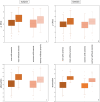In vitro blood sample assessment: investigating correlation of laboratory hemoglobin and spectral properties of dual-energy CT measurements (ρ/Z)
- PMID: 38856781
- PMCID: PMC11557693
- DOI: 10.1007/s00330-024-10820-6
In vitro blood sample assessment: investigating correlation of laboratory hemoglobin and spectral properties of dual-energy CT measurements (ρ/Z)
Abstract
Objectives: Our study comprised a single-center retrospective in vitro correlation between spectral properties, namely ρ/Z values, derived from scanning blood samples using dual-energy computed tomography (DECT) with the corresponding laboratory hemoglobin/hematocrit (Hb/Hct) levels and assessed the potential in anemia-detection.
Methods: DECT of 813 patient blood samples from 465 women and 348 men was conducted using a standardized scan protocol. Electron density relative to water (ρ or rho), effective atomic number (Zeff), and CT attenuation (Hounsfield unit) were measured.
Results: Positive correlation with the Hb/Hct was shown for ρ (r-values 0.37-0.49) and attenuation (r-values 0.59-0.83) while no correlation was observed for Zeff (r-values -0.04 to 0.08). Significant differences in attenuation and ρ values were detected for blood samples with and without anemia in both genders (p value < 0.001) with area under the curve ranging from 0.7 to 0.95. Depending on the respective CT parameters, various cutoff values for CT-based anemia detection could be determined.
Conclusion: In summary, our study investigated the correlation between DECT measurements and Hb/Hct levels, emphasizing novel aspects of ρ and Zeff values. Assuming that quantitative changes in the number of hemoglobin proteins might alter the mean Zeff values, the results of our study show that there is no measurable correlation on the atomic level using DECT. We established a positive in vitro correlation between Hb/Hct values and ρ. Nevertheless, attenuation emerged as the most strongly correlated parameter with identifiable cutoff values, highlighting its preference for CT-based anemia detection.
Clinical relevance statement: By scanning multiple blood samples with dual-energy CT scans and comparing the measurements with standard laboratory blood tests, we were able to underscore the potential of CT-based anemia detection and its advantages in clinical practice.
Key points: Prior in vivo studies have found a correlation between aortic blood pool and measured hemoglobin and hematocrit. Hemoglobin and hematocrit correlated with electron density relative to water and attenuation but not Zeff. Dual-energy CT has the potential for additional clinical benefits, such as CT-based anemia detection.
Keywords: Anemia; Blood; Computer-assisted radiographic image interpretation; Dual-energy computed tomography; X-ray computed tomography scanners.
© 2024. The Author(s).
Conflict of interest statement
Figures






Similar articles
-
Evaluation of Quantitative Dual-Energy Computed Tomography Parameters for Differentiation of Parotid Gland Tumors.Acad Radiol. 2024 May;31(5):2027-2038. doi: 10.1016/j.acra.2023.08.024. Epub 2023 Sep 18. Acad Radiol. 2024. PMID: 37730491
-
Synthetic Extracellular Volume Fraction Derived Using Virtual Unenhanced Attenuation of Blood on Contrast-Enhanced Cardiac Dual-Energy CT in Nonischemic Cardiomyopathy.AJR Am J Roentgenol. 2022 Mar;218(3):454-461. doi: 10.2214/AJR.21.26654. Epub 2021 Oct 13. AJR Am J Roentgenol. 2022. PMID: 34643105
-
Utility of dual-energy CT for predicting the vascularity of meningiomas.Eur J Radiol. 2020 Feb;123:108790. doi: 10.1016/j.ejrad.2019.108790. Epub 2019 Dec 13. Eur J Radiol. 2020. PMID: 31864141
-
Improved dose calculation accuracy for low energy brachytherapy by optimizing dual energy CT imaging protocols for noise reduction using sinogram affirmed iterative reconstruction.Z Med Phys. 2016 Mar;26(1):75-87. doi: 10.1016/j.zemedi.2015.09.001. Epub 2015 Oct 1. Z Med Phys. 2016. PMID: 26422576
-
Quantitative multi-energy CT in oncology: State of the art and future directions.Eur J Radiol. 2025 Jan;182:111840. doi: 10.1016/j.ejrad.2024.111840. Epub 2024 Nov 19. Eur J Radiol. 2025. PMID: 39581021 Review.
Cited by
-
Performance comparison of dual-layer detector CT parameters from different blood vessels in the detection of anemia.Quant Imaging Med Surg. 2025 Jun 6;15(6):4960-4971. doi: 10.21037/qims-24-1671. Epub 2025 May 27. Quant Imaging Med Surg. 2025. PMID: 40606350 Free PMC article.
-
Dual- energy CT versus single-energy CT for estimation of hematocrit and hemoglobin in the brain: an in vivo analysis.Neuroradiology. 2025 Jul 14. doi: 10.1007/s00234-025-03700-3. Online ahead of print. Neuroradiology. 2025. PMID: 40658143
References
MeSH terms
Substances
Grants and funding
LinkOut - more resources
Full Text Sources
Medical

